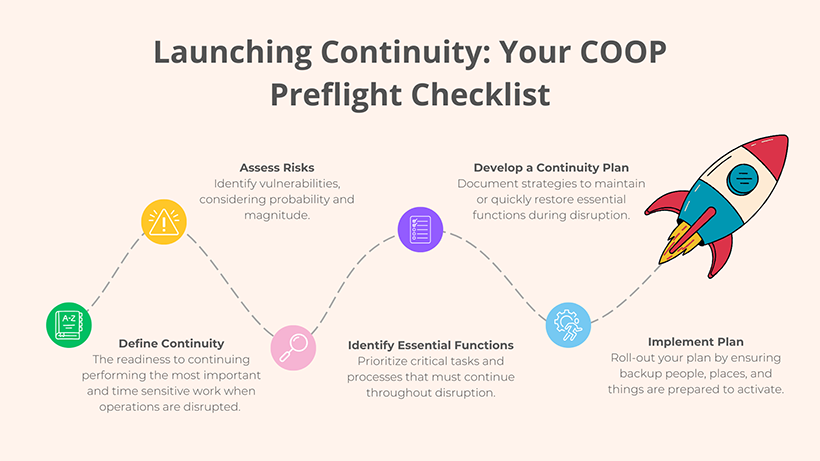What is COOP?
Continuity of Operations (COOP) is the readiness to continuing performing the most important and time sensitive work, even when disrupted by a big emergency.
Essential processes are urgent, important, and time-sensitive tasks that must continue to avoid negative outcomes.
How does an emergency impact my working and learning environment?
We categorize resources needed for operations as “People, Places, and Things.” Here are examples of how these resources can be affected during a continuity event:
People: Unavailable due to injury, illness, or personal obligations.
Places: Inaccessible due to infrastructure damage, life-safety, or health-safety reasons.
Things: Damaged or inoperable critical applications, communication resources, and equipment.
How can my division, department, or unit prepare for a continuity event?
Continuity planning considers what’s most essential and identifies realistic strategies for overcoming the absence of a key person, place, or thing. Use the below “Preflight Checklist” to evaluate your department’s readiness to perform during and after an emergency.

Scenario: A Disruption to Campus
Imagine it’s the start of the fall semester. Students are arriving, classes are underway, and your department is operating at full speed. Suddenly, a water main break floods your building overnight, rendering it unusable for several weeks. Access to offices, equipment, and critical records is cut off. Staff are unable to enter the building, and your daily operations come to a halt.
Questions to Consider
- What are the most essential functions my department must continue during a disruption?
- Do we know who is responsible for those functions, and do we have backups identified?
- Can our team work remotely or from an alternate location if needed?
- Do we have access to the tools, documents, and systems needed off-site?
- How would we communicate with our team and partners during an emergency?
- Have we recently reviewed or tested our department’s COOP plan?
Are You Prepared?
The Office of Emergency Management is here to help you design and maintain your continuity plans. We utilize an innovative software to design, maintain, and compile data from our plans to build a more resilient campus. If you are interested in taking a deeper dive into continuity, please reach out to emergencymanagement@umaryland.edu.
There are several resources available to you that guide you through your plan development:
- Play the UMB Prepared Card Game with your colleagues!
- Department Continuity Planner Checklist offers ways to proactively identify secondary and alternate people, places, and things.
- Alternate Space Requirements Tool examines space requirements to assist in relocating essential functions, services, or operations to an alternate facility.
- COOP Roll-Out Checklist walks you through next steps for ensuring your back-up processes are in place prior to a continuity event.
COOP Plan Maintenance
To maintain your Department/School Continuity of Operations (COOP) Plan, updates should be made bi-annually by the departmental continuity planner. However, some criteria might require updates sooner. Criteria that may warrant an update change prior to this timeline include, but are not limited to:
- Organizational changes, priorities, or other factors that impact essential functions for your department/school.
- Personnel changes that impact the Primary or Backup individuals for each essential function.
- Changes in software, equipment, or other resources used to perform essential functions.
- Changes in the contact roster.
Once changes are made, it is important to notify newly appointed continuity personnel and share the plan electronically, schedule a meeting to discuss the plan and continuity strategies, and take the necessary steps to implement new or existing continuity strategies.
Questions about continuity planning?
Please send an email to EmergencyManagement@umaryland.edu and a member of the UMB Office of Emergency Management will contact you.


